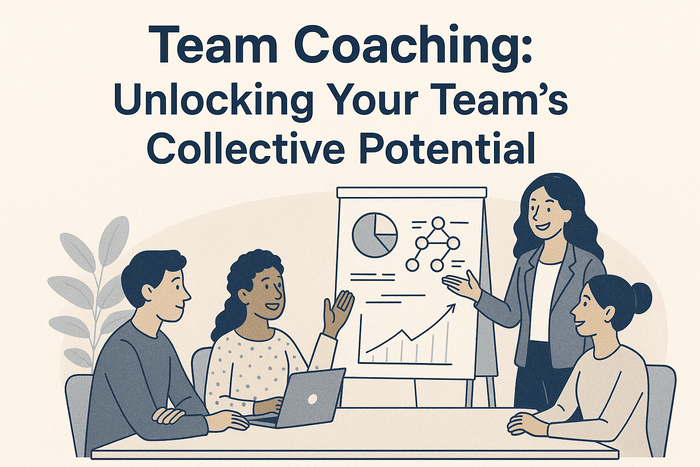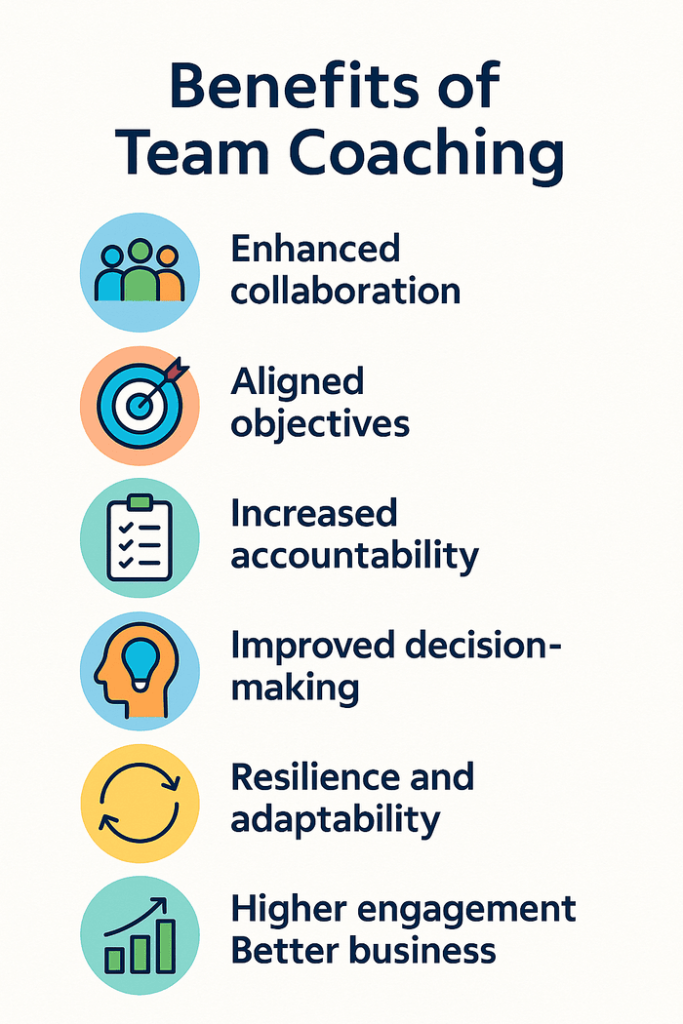
India’s economy has transformed dramatically over the last decade, and the demand for top business coach India services has grown...
In today’s fast‑paced, interconnected world, high‑performing teams are essential for organisational success. Yet many teams struggle with miscommunication, unclear goals and recurring conflicts. Individual coaching alone cannot fix systemic issues. Team coaching is a structured process that works with the entire group to enhance how they function together. By improving trust, communication and alignment, team coaching unlocks the collective potential of a group and drives sustained performance. This comprehensive guide explores what team coaching is, why it matters, core principles, the role of a team coach, tools and techniques, benefits, challenges, implementation strategies and the future of team coaching.

Research indicates that organisations with well‑coached teams experience significant benefits. A Simply.Coach article cites a 21% increase in profitability for organisations with well‑coached teams due to enhanced collaboration and alignment . Miscommunication, unclear goals and recurring conflicts are common obstacles that slow progress . Team coaching addresses these issues by facilitating shared understanding, improving communication and aligning individual goals with the team’s objectives .
While individual coaching targets personal growth, team coaching focuses on collective dynamics. It helps a group function as a cohesive unit, ensuring that everyone contributes to a shared vision . This shift from “me” to “we” encourages synergy: individual strengths complement one another, and weaknesses are compensated collectively. Team coaching is particularly relevant in environments where cross‑functional collaboration, innovation and adaptability are critical.
Team coaching involves working with an intact team over a series of sessions to improve its collective performance, communication and collaboration . Unlike team building (often a one‑off event) or group training (focused on skill development), team coaching is an ongoing process where the coach facilitates meaningful conversations, creates psychological safety and helps the team develop new behaviours. The focus is on the system rather than individual personalities.
Successful team coaching is guided by several principles. These principles provide a roadmap for coaches and teams to maximise their collective potential.
Aligning individual and team goals is foundational. A coach helps team members see how their personal ambitions contribute to the broader mission . Without this alignment, team members may pursue conflicting agendas, leading to friction. By co‑creating a shared vision, the team builds cohesion and a sense of ownership.
Every team operates within a larger system—department, organisation, industry and society. A systems thinking perspective recognises that issues often stem from interactions between the team and its environment . For example, a team may struggle not because of internal dysfunction but due to conflicting directives from leadership. A coach helps the team map these influences and design strategies to navigate them.
Effective communication is the backbone of teamwork. Coaches facilitate open dialogue, encouraging members to express thoughts, concerns and ideas . They promote active listening, reflection and clarity. Collaboration goes beyond communication: it involves leveraging diverse skills and perspectives to solve problems collectively. Building trust is crucial; when team members trust each other, they share information more openly and make decisions faster.
Psychological safety is the belief that one can speak up without fear of being punished or humiliated. It fosters creativity, innovation and engagement. Coaches create psychological safety by modelling vulnerability, encouraging empathy and ensuring everyone’s voice is heard . Teams with high psychological safety are more likely to experiment, learn from mistakes and adapt quickly.
Team coaching distributes ownership across members. Rather than the leader bearing all responsibility, each member is accountable for team success. This shared ownership encourages commitment, autonomy and mutual support. Accountability structures—such as agreements on roles, expectations and feedback—ensure that tasks are completed and learning is integrated.
Team coaching is not a one‑time intervention. It establishes a culture of continuous learning, where feedback is seen as growth‑enhancing and experimentation is encouraged. Teams review progress, celebrate achievements, analyse failures and integrate lessons into future actions. This iterative process builds resilience and adaptability.
A team coach wears multiple hats: guide, facilitator, observer and challenger. According to Simply.Coach, the coach’s role includes guiding discussions, facilitating processes, assessing dynamics and creating psychological safety . Let’s unpack each component:
As a guide, the coach leads the team through stages of development, from goal alignment to conflict resolution. They design meeting structures, set agendas and ensure conversations remain productive. As a facilitator, they encourage participation, manage energy and keep the focus on the collective agenda rather than individual agendas .
Coaches observe verbal and non‑verbal cues, group dynamics and decision‑making processes. They may use tools like 360‑degree feedback, personality assessments or diagnostic interviews to assess the team’s strengths and gaps . This information guides interventions and customises the coaching approach.
Psychological safety is not accidental; it is cultivated. Coaches model curiosity, empathy and non‑judgment. They establish ground rules that encourage open sharing and vulnerability . They also address any behaviours that undermine safety, such as sarcasm, interruptions or blaming.
Reflection is the engine of learning. The coach prompts the team to examine what worked, what didn’t and why. They introduce frameworks (e.g., debrief structures like “What? So what? Now what?”) and encourage collective sense‑making. This reflective process anchors learning and encourages experimentation.
Finally, the coach challenges assumptions, biases and complacency. They ask provocative questions, highlight blind spots and invite the team to consider alternative perspectives. Challenging is done with care and respect, balancing support and stretch.
Team coaching uses a variety of techniques and tools to foster collaboration, communication and performance . Below are key approaches:
Active listening involves paying full attention, suspending judgment and reflecting back what is heard. The coach models this and encourages team members to do the same. Structured feedback mechanisms—such as regular check‑ins, “start‑stop‑continue” exercises or peer‑to‑peer feedback—allow teams to address issues before they become major problems . Tools like Zoom or Slack can facilitate real‑time communication in virtual teams .
Assessments provide a data‑driven foundation for coaching. A 360‑degree feedback process gathers perspectives from all team members, highlighting strengths and areas for improvement . Communication style assessments (e.g., DiSC, MBTI) reveal preferences and blind spots . Team cultural surveys measure trust, clarity and alignment. These tools help tailor the coaching approach.
Structured activities—such as problem‑solving challenges, trust exercises or off‑site retreats—build relationships, promote collaboration and deepen trust . Team building is not an end in itself but supports coaching goals by fostering cohesion and fun. The coach designs activities aligned with the team’s objectives and debriefs them to extract learning.
Coaches use frameworks to structure conversations:
Visual aids like whiteboards, digital canvases or mind maps help teams externalise ideas and see patterns. Visualising stakeholder maps, process flows or decision trees aids systems thinking and enhances group memory.
Clear agreements, role charters and accountability partners ensure that insights translate into action. Coaches encourage teams to document decisions, track progress and hold each other accountable. Regular “sprint retrospectives” or “after‑action reviews” maintain momentum.

The benefits of team coaching span performance, culture and individual satisfaction:
Team coaching is powerful, but it’s not without challenges:
Anticipating these challenges and designing mitigation strategies increases the likelihood of successful outcomes.
Implementing team coaching involves several stages:
It’s important to distinguish team coaching from related approaches:
Team coaching may integrate elements of these interventions but remains distinct in its long‑term, systemic and developmental focus.
A software development company assembled a cross‑functional team (developers, designers, marketers) to launch a new product. Initially, the team lacked a shared vision, leading to siloed efforts and delays. A team coach facilitated workshops to co‑create a vision and clarify roles. Using the GROW model, the team set quarterly goals and identified obstacles. They implemented regular feedback sessions and 360‑degree assessments. Within six months, communication improved, tasks were completed faster and the product launched ahead of schedule.
In a finance department plagued by fear of mistakes, employees hesitated to report errors. A coach introduced psychological safety concepts and facilitated sessions where members shared personal stories and vulnerabilities. Using the SCARF model, the team explored how status and certainty influenced behaviour. Over time, trust grew; reporting errors became normalised, and the department proactively addressed issues, saving the company money and reducing stress.
A multinational corporation’s marketing team was scattered across three continents. Virtual meetings lacked engagement, and cultural differences led to misunderstandings. The coach implemented a “virtual coffee” ritual where team members shared personal highlights, fostering connection. They used collaboration tools and set norms for communication response times. Cultural awareness training helped members appreciate different perspectives. The team began meeting deadlines and developing creative campaigns collaboratively.
As work becomes more complex and distributed, team coaching will continue to evolve. Trends include:
Although team coaching has gained prominence in recent decades, its roots trace back to the emergence of group dynamics studies in the early twentieth century. Psychologist Kurt Lewin coined the term “group dynamics” and emphasised that behaviour is a function of the person and the environment. Later, Bruce Tuckman introduced his now‑famous model of group development—forming, storming, norming, performing and adjourning—which highlighted predictable stages that teams pass through. In the 1980s and 1990s, organisational development experts began applying systems theory to teams, recognising that interventions must address interpersonal, structural and environmental factors. The term “team coaching” emerged as coaches integrated these insights with methodologies from sports coaching, therapy and organisational psychology. Today, team coaching draws upon disciplines such as positive psychology, neuroscience and agile project management to support teams in navigating complexity. Understanding this evolution underscores why team coaching is more than a fad; it is grounded in decades of research and practice.
While the GROW, SCARF and Tuckman models provide useful lenses, many other frameworks inform practice:
Selecting the right framework depends on context, goals and challenges. Experienced coaches often blend elements to create a bespoke approach.
While coaches facilitate the process, leaders play a crucial role in supporting it:
Without engaged leadership, team coaching outcomes may be limited. When leaders fully embrace the process, its impact is amplified.
Organisations investing in team coaching want evidence of value. Measuring impact involves both qualitative and quantitative metrics:
Although calculating ROI can be complex, many organisations find that improved performance, reduced conflict and increased engagement justify the investment.
Team coaching is nuanced. Common mistakes include:
Being aware of these pitfalls helps design effective, respectful and impactful coaching engagements.
Choosing the right team coach is pivotal. Consider the following criteria:
Interview multiple candidates, request references and discuss success metrics. A good coach will ask probing questions and challenge assumptions before proposing a solution.
Team coaching doesn’t exist in isolation. For maximum impact, integrate it with:
Integration ensures that insights gained in team coaching are reinforced, applied and scaled across the organisation.
Team coaching is a transformative practice that elevates groups from collections of individuals to high‑performing ecosystems. By focusing on collective goals, systems thinking, communication, psychological safety and continuous learning, a team coach helps unlock the latent potential within every team. The process requires commitment—from leaders who champion coaching, from team members who lean into vulnerability and from coaches who skillfully guide, challenge and support. The rewards are substantial: improved collaboration, innovation, engagement and results. In an increasingly complex world, investing in team coaching is not a luxury but a strategic imperative for organisations seeking sustainable success.
Ultimately, team coaching is about cultivating collective intelligence—the ability of a group to think, learn and create together in ways that exceed the sum of individual contributions. It calls us to reimagine leadership not as command and control but as facilitation and empowerment. Whether you are a leader looking to ignite your team, a coach seeking to expand your practice or a team member wanting to contribute fully, embracing team coaching principles can open doors to new possibilities. As more organisations adopt this practice, it has the potential to transform workplaces into communities of curiosity, resilience and shared purpose. The journey requires patience and persistence, but the payoff—a team that truly functions as one—makes every step worthwhile.
Team coaching is an ongoing process that enhances collective performance, communication, and collaboration by focusing on team dynamics and shared goals. Unlike team building (short-term rapport-building events) or training (skill-focused), it addresses systemic issues and fosters long-term behavioral change.
Core principles include focusing on collective goals, applying systems thinking to understand broader influences, promoting open communication and collaboration, creating psychological safety, ensuring shared responsibility and accountability, and fostering continuous learning and adaptation.
A team coach acts as a guide, facilitator, observer, and challenger. They structure discussions, assess dynamics, build psychological safety, encourage reflection and learning, and challenge assumptions to help the team align and grow.
Techniques include active listening, structured feedback (e.g., start-stop-continue), assessment tools (e.g., 360-degree feedback, DiSC), facilitation frameworks (e.g., GROW, SCARF, Tuckman’s Stages), visual aids (e.g., mind maps), and accountability structures like role charters or retrospectives.
Benefits include enhanced collaboration, aligned objectives, increased accountability, improved decision-making, resilience, and better business outcomes (e.g., 21% profitability increase). Challenges include resistance to change, hidden agendas, time constraints, remote work barriers, and cultural differences, requiring tailored strategies and leadership support.

India’s economy has transformed dramatically over the last decade, and the demand for top business coach India services has grown...

When searching for a certified life coach program price, it’s natural to start by comparing tuition fees. Aspiring coaches want...

Neuro-Linguistic Programming (NLP) is experiencing a resurgence in India. Social media, workshops and high-energy seminars promise instant breakthroughs by rewiring...

Many professionals pursue the title of Certified Organizational Development Coach with the expectation that a credential alone will open corporate...

Some providers offer to fast-track you to PCC status through purely online modules for a fraction of the cost of...

Executive coaching has evolved from a niche service for struggling leaders into a strategic investment for organisations aiming to build...

When prospective coaches research training options, cost is often the first number they look for. A quick internet search produces...

Deciding to invest in life coach training programmes can be a transformative milestone in your personal and professional journey. In...

Choosing the right online life coaching courses can be one of the most transformative decisions you ever make.